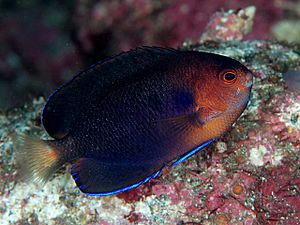Orange angelfish facts for kids
Quick facts for kids Orange angelfish |
|
|---|---|
 |
|
| Conservation status | |
| Scientific classification | |
| Synonyms | |
|
The orange angelfish, also known as Centropyge fisheri, is a beautiful small fish. It is a type of marine angelfish and belongs to the Pomacanthidae family. You can find this colorful fish living in the warm waters of the Indo-Pacific region. It has many other names like whitetail angelfish or Fisher's pygmy angelfish.
Contents
What Does It Look Like?
The orange angelfish can be different colors. Some are deep blue, while others are more orange-brown. Its tail fin is usually whitish or light yellow and looks almost clear.
The fins on its back (dorsal), belly (anal), and sides (pelvic) have bright blue edges. You can also see blue lines along the back and belly fins. This fish is quite small, growing up to about 8.4 centimeters (3.3 inches) long.
Where Does It Live?
The orange angelfish lives in a very large area called the Indo-Pacific. You can find it along the coast of East Africa, in places like Somalia and Kenya. It also lives across the Indian Ocean and into the Pacific Ocean.
Its home stretches all the way to Hawaii and Johnston Atoll. It can be found north near southern Japan and south near the Great Barrier Reef in Australia. In Australia, it lives near Christmas Island and the Cocos (Keeling) Islands. It also swims in the waters off Western Australia and in the Timor Sea.
Its Home and Habits
Orange angelfish usually live in waters that are 3 to 60 meters (10 to 200 feet) deep. They love to live on coral reefs. You can find them in areas with lots of coral, like reef slopes and places with rocky rubble. They often hang out where there are brittle corals and special algae.
These fish are often seen in small groups. They mostly eat algae, which is a type of plant. But they also munch on some worms and small crustaceans.
How It Reproduces
The orange angelfish has an interesting way of reproducing. They are what we call "protogynous hermaphrodites." This means they are born female. If the main male in a group is gone, the strongest female can change into a male! This helps the group keep reproducing.
About Its Name
The orange angelfish was first officially described in 1904. An American fish scientist named John Otterbein Snyder gave it the name Holocanthus fisheri. He found the first one near Diamond Head, Hawaii in Oahu.
The name "fisheri" was given to honor another scientist named Walter Kenrick Fisher. He was a zoologist from Stanford University. Later, scientists decided that a fish thought to be a different species, C. flavicauda, was actually the same as C. fisheri. So now, they are considered the same fish.


